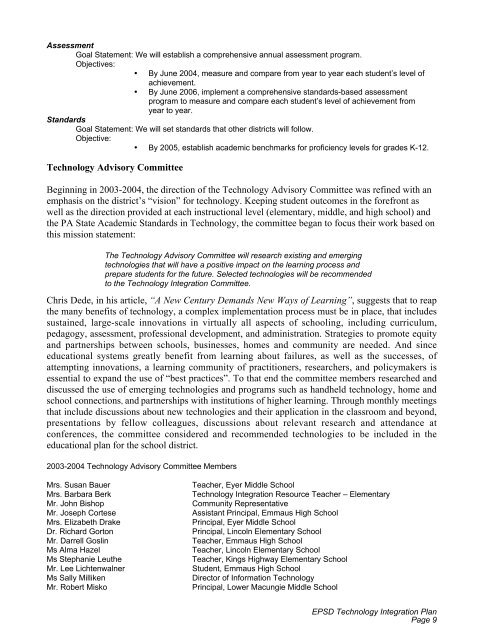EPSDtechintplan2004
EPSDtechintplan2004
EPSDtechintplan2004
You also want an ePaper? Increase the reach of your titles
YUMPU automatically turns print PDFs into web optimized ePapers that Google loves.
Assessment<br />
Goal Statement: We will establish a comprehensive annual assessment program.<br />
Objectives:<br />
• By June 2004, measure and compare from year to year each student’s level of<br />
achievement.<br />
• By June 2006, implement a comprehensive standards-based assessment<br />
program to measure and compare each student’s level of achievement from<br />
year to year.<br />
Standards<br />
Goal Statement: We will set standards that other districts will follow.<br />
Objective:<br />
• By 2005, establish academic benchmarks for proficiency levels for grades K-12.<br />
Technology Advisory Committee<br />
Beginning in 2003-2004, the direction of the Technology Advisory Committee was refined with an<br />
emphasis on the district’s “vision” for technology. Keeping student outcomes in the forefront as<br />
well as the direction provided at each instructional level (elementary, middle, and high school) and<br />
the PA State Academic Standards in Technology, the committee began to focus their work based on<br />
this mission statement:<br />
The Technology Advisory Committee will research existing and emerging<br />
technologies that will have a positive impact on the learning process and<br />
prepare students for the future. Selected technologies will be recommended<br />
to the Technology Integration Committee.<br />
The Technology Advisory Committee will research existing and emerging<br />
Chris Dede, in his article, “A New Century Demands New Ways of Learning”, suggests that to reap<br />
the many benefits of technology, a complex implementation process must be in place, that includes<br />
sustained, large-scale innovations in virtually all aspects of schooling, including curriculum,<br />
pedagogy, assessment, professional development, and administration. Strategies to promote equity<br />
and partnerships between schools, businesses, homes and community are needed. And since<br />
educational systems greatly benefit from learning about failures, as well as the successes, of<br />
attempting innovations, a learning community of practitioners, researchers, and policymakers is<br />
essential to expand the use of “best practices”. To that end the committee members researched and<br />
discussed the use of emerging technologies and programs such as handheld technology, home and<br />
school connections, and partnerships with institutions of higher learning. Through monthly meetings<br />
that include discussions about new technologies and their application in the classroom and beyond,<br />
presentations by fellow colleagues, discussions about relevant research and attendance at<br />
conferences, the committee considered and recommended technologies to be included in the<br />
educational plan for the school district.<br />
2003-2004 Technology Advisory Committee Members<br />
Mrs. Susan Bauer Teacher, Eyer Middle School<br />
Mrs. Barbara Berk Technology Integration Resource Teacher – Elementary<br />
Mr. John Bishop Community Representative<br />
Mr. Joseph Cortese Assistant Principal, Emmaus High School<br />
Mrs. Elizabeth Drake Principal, Eyer Middle School<br />
Dr. Richard Gorton Principal, Lincoln Elementary School<br />
Mr. Darrell Goslin Teacher, Emmaus High School<br />
Ms Alma Hazel Teacher, Lincoln Elementary School<br />
Ms Stephanie Leuthe Teacher, Kings Highway Elementary School<br />
Mr. Lee Lichtenwalner Student, Emmaus High School<br />
Ms Sally Milliken Director of Information Technology<br />
Mr. Robert Misko Principal, Lower Macungie Middle School<br />
EPSD Technology Integration Plan<br />
Page 9


